The Best Plants for Hanging Baskets (Flowers and Other Plants)
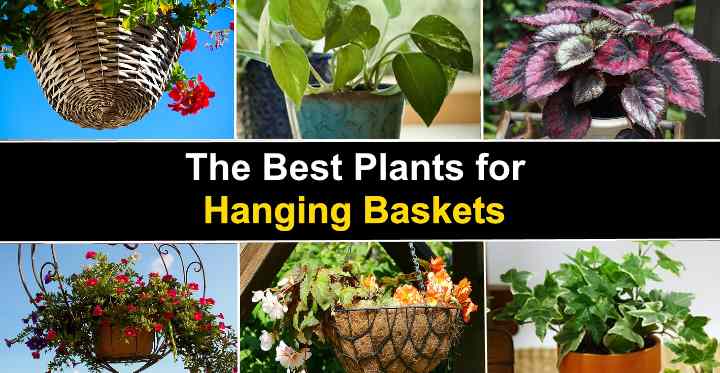
Hanging baskets are a beautiful addition to any room or outdoor area. The best plants for hanging baskets have bright, colorful flowers, dangling stems, and lush foliage to create a stunning look. Hanging basket plants can be annuals or perennials, and some thrive in the shade, whereas other plants need full sun to blossom. Whatever type of flower you choose for your hanging basket, you’ll find they are surprisingly easy to care for.
The best plants for hanging baskets are flowering begonias, beautiful dangling fuchsias, colorful verbena, blooming petunias, and bushy flowering lobelia. If you’ve got a dim room, the best hanging basket plants are trailing English ivy, tradescantias, golden pothos for their variegated leaves, peperomias for their exotic foliage, and wax vines with their delightful hanging flowers.
Depending on the type of plants in your hanging basket, you could have a stunning ball of colorful blooms. Or, you could have long trailing stems that dangle down toward the floor. Other plants provide a showy cascading display of flowers and greenery. So, there are bound to be many hanging basket plants to suit your décor.
In this article, you will learn how to choose from the best plants for hanging baskets. You will also find how to care for any type of hanging basket plant.
How to Choose the Best Plants for Hanging Baskets
Before you start picking a plant to hang up in a basket, there are a few things to consider. The two main factors to successfully grow hanging baskets are:
- Location
- Care requirements
Location is usually one of the top considerations for choosing the best plants for hanging baskets. For example, will your hanging baskets be outdoors or indoors? If you want colorful flowers hanging on your porch or beside your door, think about how much sunshine the area gets. But if your hanging basket plants will be indoors, away from direct sunlight, you’ll need to choose suitable tropical houseplants.
You’ll also have to think about the care needs of plants you put together in one basket. Pick plants that have similar care requirements. For example, many tropical trailing plants require moist soil that never dries out or is soggy. However, some outdoor blooming plants need more frequent watering than others.
The Best Hanging Basket Plants
What are the best plants for hanging baskets to enliven a room or add color to an outdoor area? Read on to find an excellent variety of plants suitable for hanging baskets.
Golden Pothos (Epipremnum aureum)
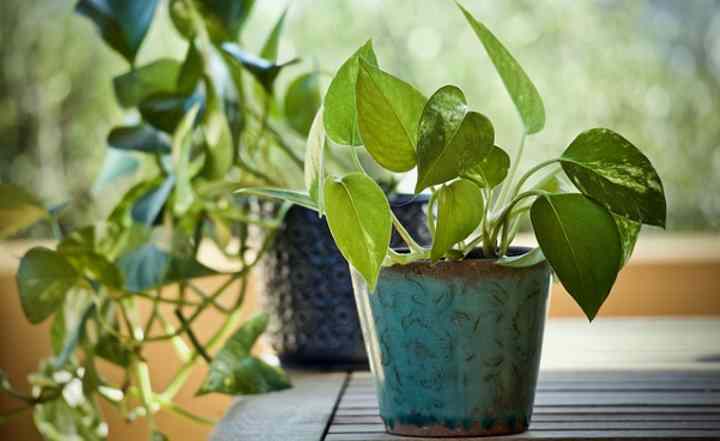
Golden pothos has long, trailing vines and green variegated leaves, making it an excellent indoor hanging basket plant. The long cascading stems can reach up to 4 ft. (1.2 m) long. Pothos plants grow well in hanging baskets where there is bright, indirect light. These houseplants also grow in low-light conditions—although the variegation won’t be as striking.
Pothos plants are low-maintenance houseplants, making them excellent hanging plants for beginners. These delightful tropical plants thrive in average room temperatures and moderate humidity.
Tradescantia
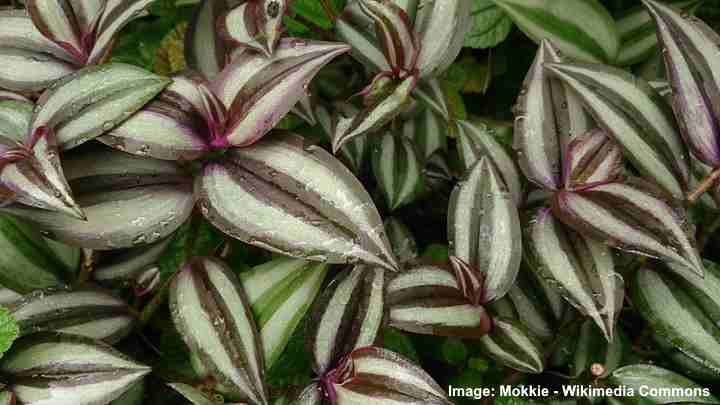
Also called spiderwort, wandering Jew, or Indian paint, Tradescantias are the perfect hanging basket plant. The long dangling stems grow well indoors and outdoors. Tradescantias are attractive houseplants due to their colorful foliage. Long or short elongated lanceolate leaves can have purple, green, or white colors. Some leaves have variegation with colorful stripes. Grow as a perennial evergreen plant that flowers under the right conditions.
Although you can hang these vining plants in shady places, they grow best in bright, indirect sunlight. Prune long straggly stems to keep the plant looking at its best. Tradescantias also produce small blue flowers—but, they can also be white, purple, or pink.
English Ivy (Hedera helix)

English ivy is a type of climbing plant with long stems that gracefully cascade down over the edge of hanging baskets. Ivy plants generally have deeply-lobed leaves that are light to dark green. These low-light hanging basket plants grow well in the shade or low-light rooms. English ivy is also a fast-growing houseplant that will help to quickly add greenery to any room, patio, or outdoor area.
When growing English ivy in a hanging basket, keep the soil moist and the air humid. English ivy is a type of flowering plant. You can grow it together in baskets with other trailing flowering plants. Or, you can plant in hanging baskets that have flowers with upward growth if you want draping green foliage.
English ivy is also on the list of top plants to clean the air. So, you could hang the plant in the corner of your bedroom, where it thrives in low light.
Begonias

Begonias are excellent flowering hanging basket plants for low-light places. There are thousands of species of begonias—many of which flower continually in the growing season. Begonias are famous for their huge, showy flowers, drooping stems, and attractive features. Some of the showiest flowers have ruffled double petals. Flowers can be yellow, pink, red, orange, or white.
Hang begonias at a front door, on a patio, or your balcony for a splash of summer color. Begonias grow best in filtered sunlight. So, if you’ve got them hanging in south-facing location, protect from the midday sun. Keep trailing begonia plants in moist soil, and you can enjoy beautiful blooms all summer.
Creeping Jenny (Lysimachia nummularia)
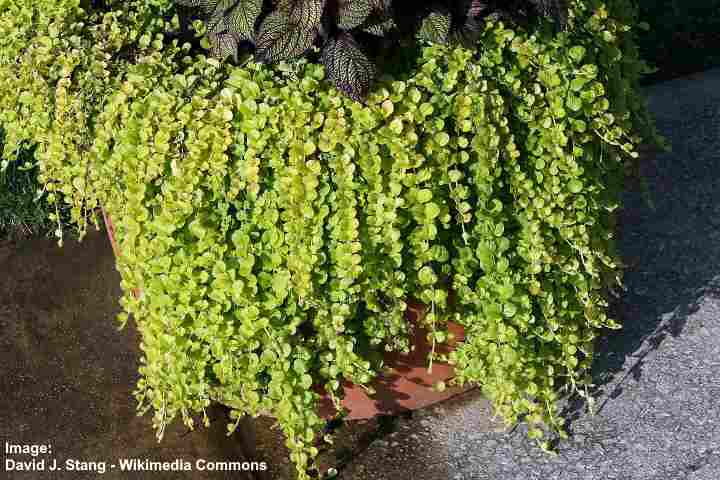
In the picture: Lysimachia nummularia ‘Aurea’
Creeping Jenny is a hanging basket plant with beautiful foliage. The small golden leaves spill gracefully down the sides of baskets and can help accent other flowering plants. The perennial plant has heart-shaped leaves on long dangling stems. Because of the trailing brightly-colored stems, the plant also has the common name “Goldilocks.”
Creeping Jenny grows best hanging in full sun or partial shade. Small yellow flowers appear in midsummer to give the dangling plant a stunning look. As well as being an excellent plant for hanging baskets, creeping Jenny is also suitable for rock gardens or as a full-sun ground cover plant.
Wax Vines (Hoya)
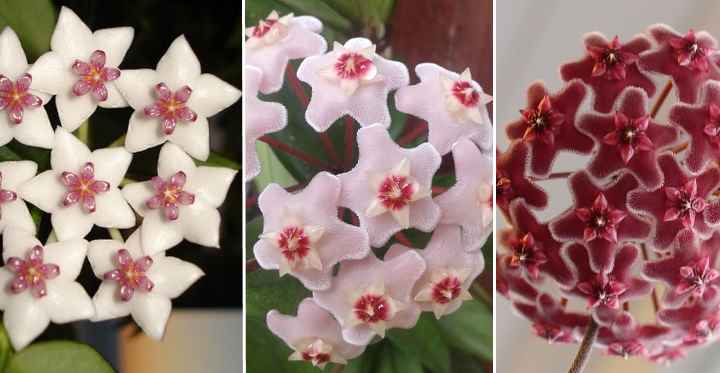
Wax plants (wax vines) are popular plants sold in hanging baskets due to their long beautiful vines. The waxy green leaves cascade over hanging baskets, pots, or urns to give a vertical accent to any shady place. You can also hang these succulent plants in bright light where the leaf colors become more vibrant.
One popular evergreen hanging basket plant is the hoya carnosa—also called the Hindu rope plant. This plant has long trailing stems with thick crinkly leaves. If you care well for your hoya, you will get rewarded with beautiful porcelain-like flowers draping over the sides of the basket.
Donkey’s Tails (Sedum morganianum)

Also called burro’s tails, the dangling stems of this vining succulent gracefully droop over the sides of hanging baskets. This succulent is a drought-resistant houseplant with small thick fleshy leaves. The succulent leaves are gray-green, and the long stems hang down vertically and are up to 24” (60 cm) long.
Donkey’s tails grow best in full sunlight. The critical care requirement of this type of succulent is not to over-water the plant. Burro’s tails plant is one of the coolest and unique plants that you can have growing outdoors or indoors.
String of Hearts (Ceropegia woodii)
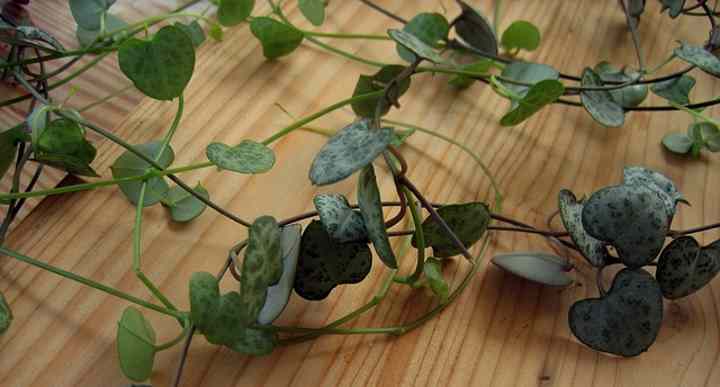
It is easy to see why this tropical hanging basket plant is called the “string of hearts.” The thin stems look like pieces of thread with heart-shaped leaves. Other names for the plant include “chain of hearts,” “hearts-on-a-string,” and “sweetheart vine.” When the hanging plant is in a sunny location, the leaves become intensely variegated.
“String of hearts” plants grow unusually-looking purple flowers and they are also on the list of the best indoor vine plants. The flowers are tubular with a ball-like shape at their base. However, this plant is usually kept as a hanging basket plant due to its elegant foliage.
String of Dolphins (Senecio peregrinus)

“String of dolphins” is a rare plant because it is difficult to find. The draping stems have succulent leaves that look like tiny dolphins jumping out of the sea. If you are fortunate enough to find this plant, keep it in a hanging basket in a bright, sunny spot. Only water when the soil dries out.
If you care for a string of dolphins correctly, the unusual plant will reward your efforts with delicate flowers. Dainty white flowers appear from May until June, and they have a distinct aroma of cinnamon.
Lipstick Plant (Aeschynanthus)
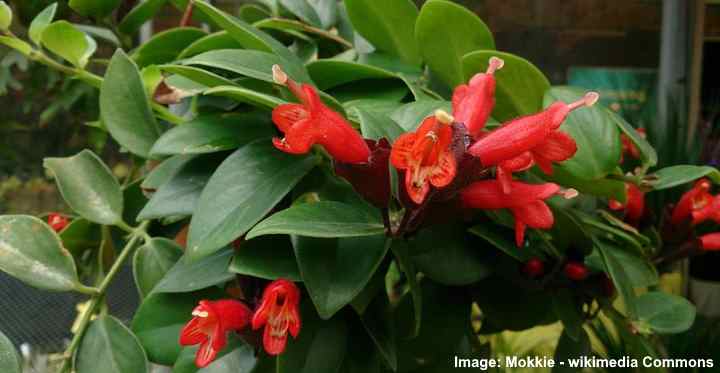
The lipstick plant is an easy-to-care-for plant, perfect for hanging baskets in rooms with bright, indirect light. The trailing vines have shiny green lanceolate leaves. When the hanging plant blooms, it produces an array of deep red, orange, or yellow flowers. The unusual flowers on lipstick plants look like small tubes of lipstick.
This tropical draping plant needs to hang in places that get plenty of light. If there’s not enough light, the plant won’t flower. For the plant to thrive, it needs moist soil that never gets too soggy. Some unusual lipstick plant cultivars have dangling stems that have curly or twisted leaves.
Radiator Plants (Peperomia)
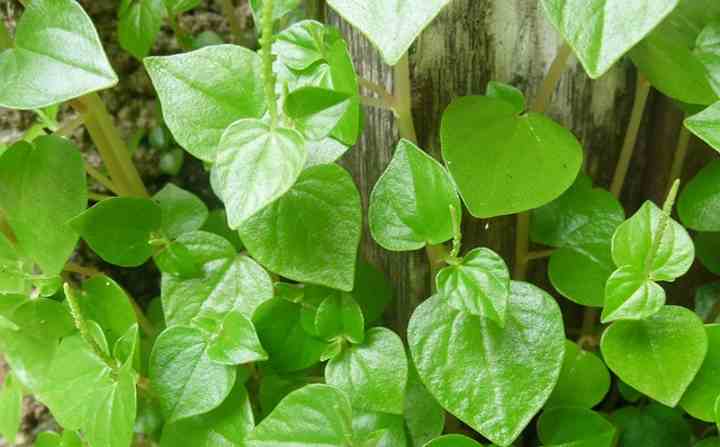
In the picture: Peperomia pellucida
Plants in the Peperomia genus are one of the easiest houseplants for hanging baskets. Radiator plants are excellent compact plants if you don’t have a lot of room where to hang them. The best types of peperomia for hanging baskets are the ground-cover varieties. These have long, spreading stems with small leaves. As the thread-like stems grow out, they start to drape over the side of baskets to fill vertical space.
Peperomia plants rarely flower indoors. So, these plants are the perfect companion plants for hanging baskets if you want lush, bushy foliage to accompany flowering plants. Choose a variegated variety of peperomia if you want your plant to make an impact hanging in a room.
Heartleaf Philodendron (Philodendron hederaceum)
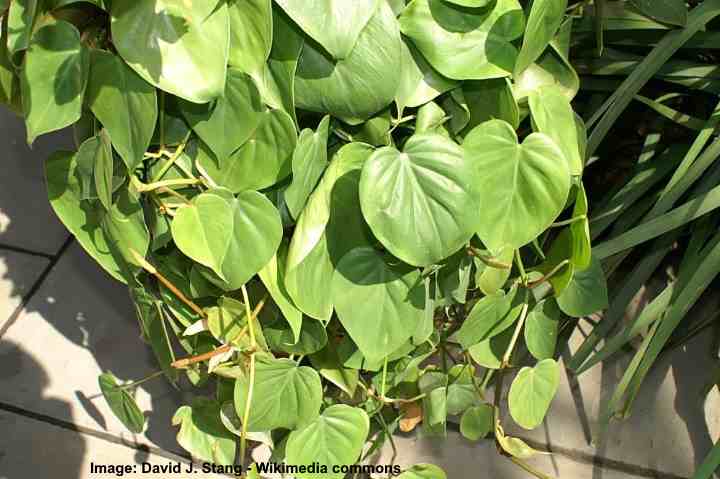
The unsupported climbing stems of heartleaf philodendrons droop down over the sides of hanging baskets. The stunning large, glossy green leaves create an immediate impact in any living space. As the common name implies, the leaves are heart-shaped and can grow up to 4” (10 cm) long.
Philodendron plants can survive in dark places and low-light conditions; however, the trailing stems may become straggly. To care for this hanging basket plant, keep it in bright light but out of direct sunlight. Philodendron is on the list of easy to care for hanging houseplants.
Strawberry Begonia (Saxifraga stolonifera)
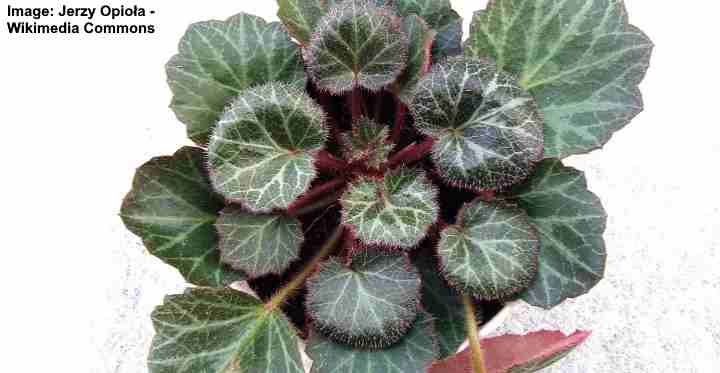
Strawberry begonias are pretty-looking plants for hanging baskets. The plant grows runners that trail over the side of pots creating delightful trailing foliage. The outstanding feature of these indoor plants is the reddish-plum colors on the underside of the leaves. In the summer, the plant produces small white flowers.
Grow these indoor hanging basket plants in warm, humid conditions with adequate ventilation. Similar to spider plants—also an excellent hanging basket plant—the base of the stems have clumps of plantlets.
Creeping Charlie (Glechoma hederacea)

This fast-growing type of ivy—the creeping Charlie—is a popular plant for hanging baskets. The thick creeping foliage cascades over the side of plant pots to form a dense hanging basket plant. The attractive leaves have light to dark green colors with some white variegation.
Hang this flowering ivy plant beside doors or in patios to provide lush green foliage. You can hang the pots in full sun or partial shade. In mid- to late-spring, attractive blue funnel-shaped flowers bloom to add some color.
Watermelon Begonia (Pellionia pulchra)
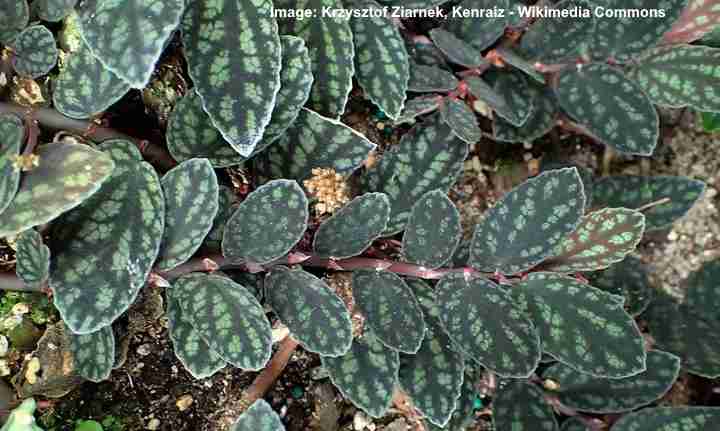
Watermelon begonias are bushy, trailing plants that are excellent for growing in hanging baskets. These sun-shy plants prefer to hang in shady places or low light areas. Under the right conditions, the creeping foliage provides dense trailing stems. The pretty leaves have a marbling pattern with various shades of green and white. Some varieties have leaves with purple veins.
These are not low-maintenance plants because they have high humidity needs. So, if you have one of these plants hanging in a dim corner, mist it regularly or use a humidifier.
Flowering Hanging Basket Plants
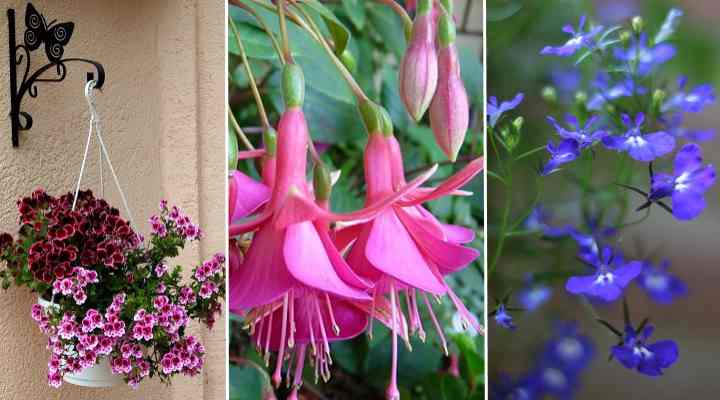
From left to right: geranium, fuchsia and lobelia
Are you looking for plants that love sunny spots and produce a multitude of colorful flowers? Then here are five types of low-maintenance outdoor hanging basket plants
Fuchsias—These flowering trailing plants are excellent for hanging baskets because their flowers dangle down. Fuchsia flowers look like small bells and are usually in varying shades of pinks, purples, or white.
Petunias—In hanging baskets, petunias will create a colorful bushy ball due to the large number of colorful flowers. Petunias are one of the best flowering plants for hanging baskets. Hang in a bright sunny spot to help these plants thrive.
Lobelia—When lobelia blooms in a hanging basket, the whole plant turns in to a mass of intensely-colored blue or purple flowers. Hang lobelia plants in a patio, balcony, or beside a door that gets partial shade. Keep the soil moist for best results.
Verbena—These plants are an excellent choice for hanging baskets outdoors in full sun. Masses of colorful flower clusters bloom continuously throughout the season. Expect white, red, purple, pink, and multicolored blossoms.
Geranium—These are popular plants to hang in containers because they thrive in direct sunlight. These flowers are suitable for hanging baskets on a south-facing patio or building. Geraniums will also bloom profusely in partial shade. Abundant flowers droop down over the containers throughout the season. Bring indoors during the winter to protect them from the cold.
Caring for Flowers in Hanging Baskets
To care for hanging basket flowering plants, only water when the soil is partly dry, and keep the soil moist without becoming waterlogged. Fertilize according to the plant’s needs and always when the soil is moist. Deadhead flowers as needed to encourage growth and blooming. Prune leggy trailing stems that look straggly hanging from the basket.
Plant experts say that you should water outdoor hanging basket plants daily during summer to keep the soil moist. Water the plants only when the top part of the soil is dry. Deep watering requires pouring in enough water until it drains out the basket. (1)
Water indoor hanging basket plants when the top one-inch (2.5 cm) of soil is dry. Take the plant to the bath or a sink and run enough water through the soil until it drains out the bottom.
Read about the best flowers for hanging baskets.
How to Plant Hanging Basket Plants
Finding a suitable container, pot, or basket to hang is also extremely important for your hanging basket plants to thrive. Usually, the best baskets should be between 14” and 16” (35 – 40 cm) wide. This size of pot gives you enough room to grow a few plants together to create a stunning floral display.
To plant hanging basket plants, you’ll also need to make sure the basket has a liner. The best type of liners are ones made from coco coir (coconut fiber). Make sure to use a well draining soil so that your plants will thrive in the hanging basket.
Related articles:
